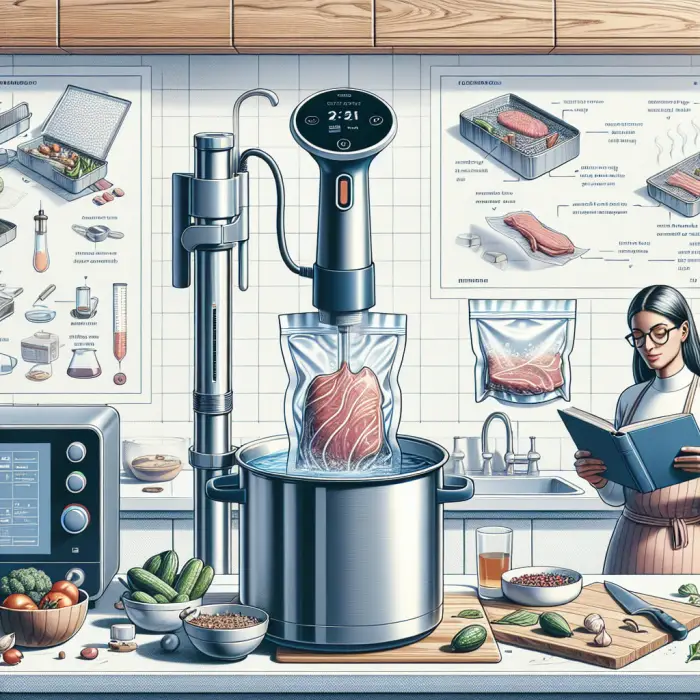
Image of sous vide activity.
Sous vide, a French term meaning “under vacuum,” is a cooking technique where food is vacuum-sealed and cooked in a temperature-controlled water bath, offering unparalleled consistency and taste.
This low-temperature, long-time cooking method, developed in France in the 1970s, has revolutionized culinary standards by enabling precision in cooking temperature, thus reducing the risk of overcooking and ensuring restaurant-quality results in the home kitchen.
What is sous vide cooking, exactly? It’s a process that delivers not only incredible taste and consistent results but also boasts versatility and waste reduction, with the capability to cook nearly anything from meats to cocktails.
This article delves into the science behind sous vide, its range, and ease for home chefs, and addresses common misconceptions, providing a comprehensive guide to mastering this innovative cooking technique.
The Science Behind Sous Vide Cooking
Understanding the science behind sous vide cooking unveils why this method is revered for its precision and consistency. Here’s a breakdown:
- Temperature Precision: Sous vide machines maintain a consistent temperature, ensuring no uneven heating areas. This precision allows the food’s internal temperature to match the water bath, achieving exact cooking.
- Three-Step Process:
- Seasoning the food.
- Sealing it in a vacuum.
- Cooking sous vide.
- Safety and Quality: Food should be vacuum-sealed when cold and fully submerged during cooking to prevent bacterial growth. Cooking below 127°F for extended periods is unsafe; thus, temperatures of 130°F or above are recommended for prolonged cooking. Vegetables require higher temperatures (183°F to 185°F) to tenderize.
This method’s reliance on precise temperature control over perfect timing minimizes the risk of overcooking, ensuring even and slow cooking.
The result? Uniformly cooked meats without the “well-done on the outside, pink on the inside” appearance and enhanced textures and flavors in both meats and vegetables.
Versatility and Range of Sous Vide Cooking
Sous vide cooking extends its versatility far beyond just meats, offering a wide array of culinary possibilities that cater to various dietary preferences and culinary needs. Here are some key highlights:
- Diverse Cooking Options:
- Delicate items like soft-boiled eggs can be cooked perfectly for a crowd, ensuring each egg is just right.
- Advanced meal prep becomes a breeze as both proteins and vegetables can be cooked, stored, and reheated with ease, maintaining their quality and taste.
- From infused syrups, for cocktails to tender vegetables and moist meats, sous vide’s range includes not just proteins but also desserts, yogurt, cheese, and even pickled vegetables.
- Creative Culinary Applications:
- Infusing alcohol and making condiments like mustard or stock for soups showcases sous vide’s capability to enhance flavors in unique ways.
- The method’s ability to cook items like cheesecake, bread pudding, and even overnight oatmeal opens up new breakfast and dessert avenues.
- Enhanced Operational Efficiency:
- Utilizing precooked proteins allows for a consistent customer experience with reduced preparation time, as finishing can be up to 50% faster than cooking from raw.
- The technique also promotes food safety, reduces waste, and streamlines kitchen operations by minimizing prep and finishing steps, thus catering to both home chefs and professional kitchens alike.
Ease of Use and Accessibility for Home Chefs
Sous vide cooking has transformed the home kitchen by making gourmet cooking more accessible. Here’s how:
- Essential Tools:
- Sous Vide Machine: Devices like the Breville Joule, which can be controlled via a smartphone app, simplify the process with presets for various foods.
-
- Sealing Options: While a vacuum sealer ensures a perfect seal, the displacement method with zip-top bags is a cost-effective alternative, eliminating the need for additional equipment.
- Cooking Container: A regular pot, Dutch oven, or even a bathtub can serve as the water bath, showcasing the method’s flexibility.
- Benefits and Accessibility:
- Precise Temperature Control: This method offers precision, reducing the risk of overcooking and ensuring even cooking, making it ideal for meats and delicate items alike.
- Affordability: A quality sous vide machine can be acquired for under $200, making this cooking technique an affordable option for many home chefs.
- Ease of Use: Sous vide is straightforward to learn and implement, with the food turning out the same every time, allowing chefs to achieve their preferred level of doneness with minimal effort.
- Versatility and Convenience:
- Wide Range of Foods: From meats to vegetables and even desserts, sous vide’s versatility is unmatched.
- Meal Prep Made Easy: Foods can be prepared, cooked, and even frozen in advance, streamlining meal planning and preparation.
- Adaptability: The technique can be performed almost anywhere with an electrical outlet, water supply, and a container, proving its adaptability.
Sous vide cooking not only elevates the home cooking experience but also democratizes gourmet cuisine, making it an invaluable addition to any home cook’s system.
Addressing Common Misconceptions and Tips for Mastery
Addressing common misconceptions about sous vide cooking and providing tips for mastery can enhance both the understanding and implementation of this culinary technique. Here are some insights and recommendations:
- Misconceptions and Corrections:
- Sous vide cooking is not inherently creativity-limiting; it allows for more kitchen space, less mess, and the ability to experiment with flavors.
- Contrary to the belief that sous vide is time-consuming, many dishes including sides, chicken, steak, and fish can be prepared in under an hour.
- While a post-sous vide sear is essential for flavor, it should be brief (45 to 90 seconds per side) to avoid overcooking.
- Flavor and Preparation Tips:
- To achieve the desired flavor, use powdered garlic or onion instead of raw, as low temperatures may not fully develop their flavors.
- Avoid stacking food in the sous vide bag as it increases thickness and cooking time; opt for a single layer or multiple bags.
- For enhanced taste, add butter during or after searing rather than in the sous vide bag.
- Serving and Cooking Efficiency:
- To keep sous vide food warm upon serving, preheat plates in a warm oven.
- Rely on precise cooking times and temperatures from reliable sources like sous vide charts or tables for the best results.
- Remember, sous vide cooking focuses on precise temperature control, making timing less critical for success.
Conclusion
Throughout this exploration of sous vide cooking, we’ve navigated the complex yet fascinating world that combines precision with versatility to revolutionize at-home gourmet cooking.
Starting with its roots in French culinary tradition, we’ve seen how the meticulous temperature control of sous vide ensures perfection in every bite, extending its benefits across a wide spectrum of foods—from meats and vegetables to desserts and cocktails.
The technique’s embrace by both professional chefs and home cooking enthusiasts underscores its significance, not only in enhancing the flavor and texture of dishes but also in promoting efficiency, flexibility, and food safety in kitchen operations.
Addressing common misconceptions hopefully sheds light on the true nature of sous vide cooking as a gateway to culinary creativity and not a limitation.
As we’ve illustrated, the potential for innovation within this cooking method is vast, encouraged by sous vide’s forgiving nature and its ability to maintain the integrity of ingredients.
As more individuals are drawn into the orbit of sous vide cooking, it stands as a beacon for those aspiring to elevate their culinary skills. In essence, mastering sous vide cooking empowers chefs at all levels to deliver consistently exquisite meals, paving the way for further exploration and mastery in the culinary arts.
FAQs
Q: What are some drawbacks of sous vide cooking? A: One significant disadvantage of sous-vide cooking is that earlier sous-vide water ovens were quite costly.
As a result, many home cooks tried to use simmering water pots for sous vide cooking, which couldn’t be accurately controlled, leading to a higher risk of food contamination.
Q: Can you explain what sous vide cooking is? A: Sous vide is a cooking method originating from France, where “sous vide” means “under vacuum.”
This technique involves vacuum-sealing food in a pouch and then cooking it in a water bath at a precisely controlled temperature.
Q: What are the fundamental steps in sous vide cooking? A: The basic sous vide cooking method involves selecting the desired final temperature for your food, such as 131°F (55°C) for a medium-rare steak.
You then heat water to that exact temperature. The food, sealed in a vacuum or Ziploc bag, is placed in the water and cooked until it reaches the same temperature as the water.
Q: What is a recommended first attempt at sous vide cooking? A: If you’re new to sous vide cooking, starting with steak is highly recommended.
Steak epitomizes the precision and perfection sous-vide can achieve, eliminating the risk of overcooking and resulting in tough and dry meat. With sous vide, you can cook a steak to the perfect level of doneness without any guesswork.

